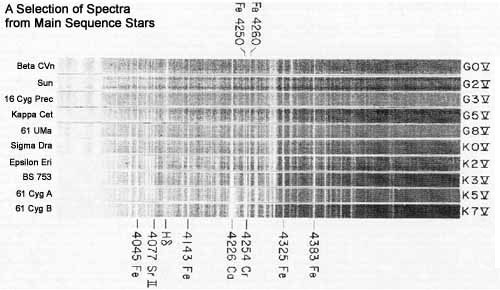Starlight - Main Sequence - O - B - A - F - G - K - M - Luminosity Classes - Spectral Class Codes
A star's spectral class code concisely conveys the star's size, temperature, composition and life cycle stage. Some example codes follow:
| Sun | G2V | Main Sequence star |
| Achenar | B3Vpe | Main Sequence star with peculiar spectrum and emission lines |
| Rigel | B8Ia | Supergiant |
| Sirius | A1Vm | Main Sequence star with metallic spectrum lines |
| Antares | M1Ib | Red Supergiant |
| Proxima Cen | M5Ve | Main Sequence Red Dwarf with emission lines |

Until recently, astronomers recorded spectra onto photographic film. Today they are more likely to employ electronic detectors and record the data directly to a computer.
Astronomers classify stars by matching records to spectra in reference catalogs.
|
Stellar spectral class codes convey three pieces of of information:
The initial letter-number pair specifies the star's spectral type (and also indicates its temperature). The spectra shown at left are arranged in order of temperature - hottest at the top. The Sun, a G2 star is slightly hotter than 16 Cyg Prec, a G3 star and slightly cooler than Beta CVn, a G0 star. Next is the star's luminosity class - the amount of light the star produces. Roman numerals, and perhaps a letter or zero are used to convey this information:
And thirdly, if the star has special features, letter codes are used to specify them:
Variable stars oscillate in spectral type - the spectral codes for the two extremes are given. There is considerable variation in code usage. Any list of spectral types should specify the convention followed. |